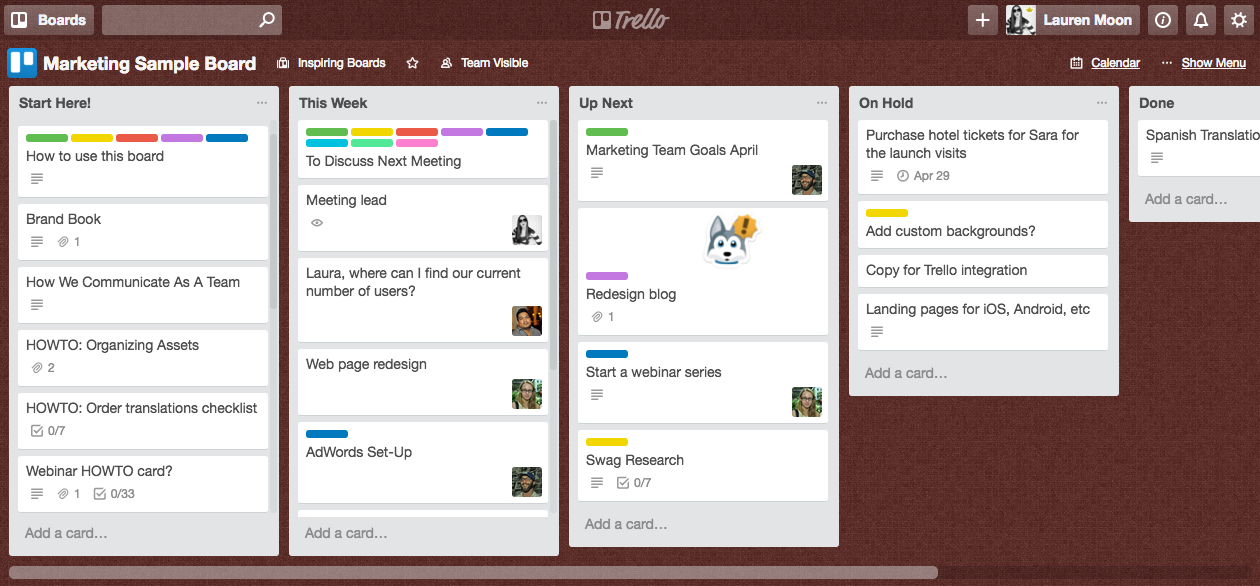It’s 3 PM. The caffeine is kicking in from your afternoon coffee, but you can’t shake the feeling of dread as you drag yourself into your team’s weekly meeting. You know it’s going to carry on forever while simultaneously accomplishing nothing. You wonder, “Does it have to be this way?”
Nay, my friend, it doesn’t. Meetings have recently gotten a bad rep. Blanket statements like “all meetings are bad” serve the same purpose as those tabloid headlines that promise “the best diet ever” while refusing to acknowledge that any diet is a fad. The commonality is that both aren’t inherently bad: the problem lies in the execution.
Running a distributed team at Trello, I understand that team meetings are crucial to making sure we’re in sync and executing on projects. Getting to the right structure has been a journey, and I’m here to teach you all of my secrets:
Step 1: Drop The Droning

Tick, tock. Tick, tock. There you go again, staring at the clock. If you want to avoid the catastrophe of a meeting with no ending in sight, make sure each has a structure.
It might seem obvious but a recent study showed that surprisingly, over 63% of meetings have no planned agenda. That is a giant no-no! When people walk into a meeting they need to know there is a beginning, middle, and end. It is not open ended, and everyone understands what needs to be accomplished in the allotted time.
On my team, we have a designated list on a Trello board entitled “To Discuss.” During each meeting, we go through the cards on this list and move them along to their proper location, whether that is an “In Progress” list, or “Up Next” for projects we want to do later, or simply archive the card if the item was discussed and has no further action items.

Sometimes this meeting lasts ten minutes, and sometimes it lasts the full allotted hour. Either way is fine. We have the time set aside for this purpose, and if we finish earlier everyone is happy to have extra time to get back to what they’re working on.
Everyone on the team understands that this is the structure, and comes into the meeting prepared. Efficiency at its finest!
Step 2: Follow The (Rotating) Leader

You’re in a meeting and… silence. You look around. No one knows what to do next, or how to move forward. Everyone is waiting for someone to take the lead. I call that #Fail.
Hear me out: Each meeting must have a leader. This person’s job is to keep things moving along, and potentially make a joke or two for smooth transitions (mine usually elicit an eye roll).
Not having a designated leader results in a heaping helping of diffusion of responsibility, or people silently waiting for someone else to take the lead. Sound familiar?
The process my team has developed is to designate a meeting lead ahead of time on a card. The card is labeled “Meeting Lead” and has the person’s face on it. Again, not rocket science.
We rotate who leads the meeting because let’s be honest, no one wants to hear the same person talk on and on all the time. This also gives everyone on the team a sense of ownership for the meeting.
To avoid confusion, we have the current meeting lead designate the next meeting lead at the end by switching out their faces on the card.
Step 3: Take A Democratic Yet Darwinistic Approach

Coming into a meeting, my team already knows the agenda is in the “To Discuss” column (covered in Step 1). But how do those cards get there?
The rule is that anyone on the team can add a card to the “To Discuss” list on our meeting board at any time. Often, cards get added with a short description, and whatever issue needs to be discussed gets resolved with comments on the card before we even meet.
So many wins here: team members feel involved because their issues get voiced and discussed, and the team wins because this approach ensures only the important issues get to a meeting. It’s truly Darwinistic: the issues that can be solved outside of the meeting are, and only the strongest, most important get discussed.
Step 4: Appoint A Scribe

You just got back from vacation and important things happened while you were out. The horror! How will you get caught up?
The truth is that meetings have to happen even if someone is sick or on vacation. That doesn’t mean those lovely vacationers (or poor sick ones) have to miss out.
To combat this problem, my team came up with the notion that a scribe (usually the meeting lead) takes notes right on the cards. So if someone has to miss a meeting, they can know exactly what happened without having to bug someone else.
We also make our board available for the company to see, so anyone can pop in and see what the marketing team discussed this week and contribute right on the cards. Promoting company transparency is always a good thing…am I right?
Extra Credit
Bada bing, bada boom. There is your surefire workflow to effective status meetings. No more sleeping, eye rolling, or time wasting. For extra credit, optimize this workflow for your own team. Keep in mind that processes like these should never be static; we’re constantly improving our meeting structure as we try different things. Some stick, and some don’t.
The most important takeaways are that team members feel involved, supported, and that their time is used effectively. And in an age where everyone could use just a little bit more time, this is a win-win for everyone.
Here’s a sample Trello board based on the meeting workflow described in this post.





 )
) 





































